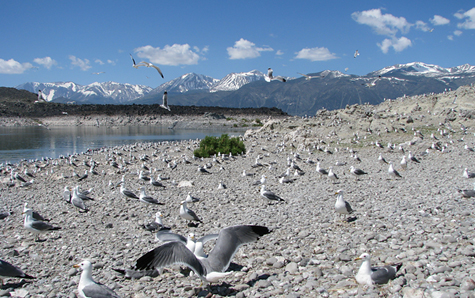
This post was written by Nick Neely, 2010 Birding Intern.

Last July, in a chicken-wire fenced plot on an islet known as Little Tahiti, California Gull banders Kristie Nelson and Nora Livingston spotted one notable adult gull among the masses. It had both a white plastic band and a metal ID band above its ankle, on the “drumstick” part of its leg (though that may be an unsavory description). Odd, they thought, no one bands that part of the leg these days. Kristie, who has headed up the gull banding on Mono Lake’s islets since 2005, remembered seeing this distinctive bird in the same corner of this particular study plot during other seasons, too. She suspected it was an old bird and knew that, in early banding days on Mono Lake, researchers had placed colored bands—white, say—on chicks from different islets.
The banding scene on the Mono Lake islets is well-described as calm and collected chaos. While the adult gulls scream bloody cacophony, two banders, including Kristie, sit on overturned crates, sheets spread across their laps like aprons. Then, brave assistants such as Nora (the Committee’s Birding Intern in 2009) hand them downy, flightless chicks from the makeshift pens and cardboard boxes into which they’ve just been corralled. The banders swiftly plop the youngster on their sides, isolate their legs, and deftly crimp on a band, or two—like cowboys tying up a lassoed calf—then make other essential measurements (and check for mites). These rambunctious “buggers” are about the size of a football, and would be cute, if they didn’t regurgitate beige brine shrimp, translucent long-legged fly larvae, red calcareous grasshopper, and the occasional pink hot dog slurry or rib bone, courtesy of dumpsters in Lee Vining. Thus, the sheets.
The researchers do their very best to get into and out of the study plots with haste, but it takes about an hour to gently process all those chicks, often 60 or more. So on Little Tahiti, while intermittently passing along squirmy chicks to Kristie, Nora spent the better part of an hour scrutinizing the metal band on this notable gull through her binoculars, squinting to read the number engraved on it from about ten feet away. Luckily, she has young eyes and, eventually, she succeeded: 07 … 85 … 169 …9 … 3.
In the fall, Kristie sent in the banding data for the season—including this anomalous adult gull’s identification—to the National Bird Banding Lab, located in Maryland. After a while, they got back to her. You’re sure it was this number? they asked. Yes, Kristie replied.
Well, as it turns out, this gull was banded as a chick in 1983 during the very first season of gull banding on Mono Lake. That makes it 26 years old (as of last July), just one month shy of the verified longevity record for California Gulls. Or, to put it another way, the bird was born seven years before fledgling Nora.

“It’s just a fabulous connection to the past,” says Kristie, precisely “the thread of continuity” to which ecological studies aspire. Quite likely, this wise old sage gull has nested on Little Tahiti for a quarter-century—in the same corner of that study plot, even. Justine Hite, who banded on the islets prior to Kristie’s tenure, also remembers seeing this gull.
All of this means, of course, that many of 0785-16993’s progeny surely wear a metal ring with a number, as well. Thirty birds, maybe, or 40—quite the Mono Lake legacy.
